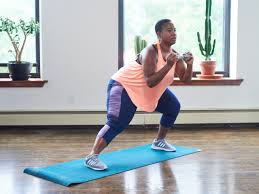Functional training has become increasingly popular in the fitness world, and for good reason. Unlike traditional weightlifting or cardio exercises that isolate specific muscle groups, functional training focuses on movements that mimic everyday activities and improve overall strength, flexibility, and balance.
One of the key principles of functional training is to train the body as a whole, rather than targeting individual muscles in isolation. This approach helps improve coordination between different muscle groups and enhances overall movement patterns. By engaging multiple muscles simultaneously, functional training not only builds strength but also improves stability and mobility.
Functional exercises often involve using equipment like kettlebells, resistance bands, medicine balls, or simply your body weight. These tools help simulate real-life movements such as pushing, pulling, squatting, twisting, and bending. By incorporating these dynamic movements into your workout routine, you can improve your ability to perform daily tasks with ease and reduce the risk of injury.
Another benefit of functional training is its adaptability to different fitness levels and goals. Whether you’re a beginner looking to build a foundation of strength or an athlete aiming to enhance performance in a specific sport, functional exercises can be tailored to meet your needs. Plus, the variety of movements and equipment options keep workouts engaging and challenging.
Research has shown that functional training not only improves physical fitness but also enhances overall well-being. By focusing on movements that translate to real-life activities, you can experience increased energy levels, better posture, and reduced joint pain. Additionally, functional training can help boost cognitive function by promoting neural connections that support coordination and motor skills.
In conclusion, incorporating functional training into your fitness routine offers a multitude of benefits for both body and mind. Whether you’re looking to enhance athletic performance or simply improve your quality of life, embracing functional exercises can help you move better, feel stronger, and live more actively.
8 Essential Tips for Effective Functional Training Workouts
- Focus on compound movements that target multiple muscle groups.
- Incorporate bodyweight exercises like squats, lunges, and push-ups.
- Include balance and stability exercises to improve core strength.
- Use functional equipment such as resistance bands, kettlebells, and medicine balls.
- Prioritize proper form and technique to prevent injuries.
- Mix up your routine to keep challenging your body and avoid plateaus.
- Listen to your body and adjust the intensity based on your fitness level.
- Consult a fitness professional for personalized guidance and program design.
Focus on compound movements that target multiple muscle groups.
When engaging in functional training, it is essential to prioritize compound movements that target multiple muscle groups simultaneously. Exercises like squats, deadlifts, push-ups, and lunges not only build strength but also improve coordination and stability across various muscle groups. By incorporating these compound movements into your workout routine, you can efficiently work multiple areas of the body at once, leading to better overall functional fitness and enhanced performance in daily activities.
Incorporate bodyweight exercises like squats, lunges, and push-ups.
To enhance the effectiveness of your functional training routine, consider incorporating bodyweight exercises such as squats, lunges, and push-ups. These fundamental movements not only target multiple muscle groups simultaneously but also improve coordination, balance, and core strength. Squats engage the lower body muscles while promoting proper alignment and mobility. Lunges help strengthen the legs and glutes while enhancing stability and flexibility. Push-ups work the upper body muscles including the chest, shoulders, and triceps, contributing to overall upper body strength and endurance. By integrating these bodyweight exercises into your workout regimen, you can build a solid foundation of functional strength that translates to improved performance in daily activities and sports.
Include balance and stability exercises to improve core strength.
Including balance and stability exercises in your functional training routine is essential for enhancing core strength. By challenging your body to maintain equilibrium during various movements, you not only strengthen the muscles in your core but also improve overall stability and coordination. These exercises engage deep core muscles that are often neglected in traditional workouts, leading to a stronger and more resilient midsection. Additionally, by focusing on balance and stability, you can reduce the risk of falls and injuries while performing daily activities, ultimately enhancing your functional fitness and quality of life.
Use functional equipment such as resistance bands, kettlebells, and medicine balls.
To maximize the effectiveness of your functional training routine, incorporating equipment like resistance bands, kettlebells, and medicine balls can elevate your workouts to the next level. These versatile tools add variety and challenge to your exercises, helping you target multiple muscle groups simultaneously and improve overall strength, stability, and coordination. Resistance bands provide adjustable resistance for both upper and lower body exercises, while kettlebells offer dynamic movements that engage core muscles and enhance functional strength. Medicine balls are excellent for explosive movements and improving power output. By incorporating these functional equipment into your workouts, you can enhance your physical performance and achieve greater functional fitness gains.
Prioritize proper form and technique to prevent injuries.
When engaging in functional training, it is essential to prioritize proper form and technique to prevent injuries. By maintaining correct alignment and movement patterns during exercises, you not only maximize the effectiveness of the workout but also reduce the risk of strain or injury. Focusing on proper form ensures that the targeted muscles are engaged efficiently while supporting joints and ligaments. Remember, quality over quantity is key when it comes to functional training – always prioritize safety and technique to achieve long-term fitness success.
Mix up your routine to keep challenging your body and avoid plateaus.
To maximize the benefits of functional training, it’s essential to mix up your routine regularly. By introducing new movements, exercises, and equipment into your workouts, you can keep challenging your body and avoid hitting plateaus. Variety not only prevents boredom but also stimulates different muscle groups, improving overall strength, flexibility, and coordination. Changing up your routine challenges your body in new ways, forcing it to adapt and grow stronger. So don’t be afraid to try new exercises or incorporate different tools into your functional training regimen to keep your workouts fresh and effective.
Listen to your body and adjust the intensity based on your fitness level.
It is crucial to listen to your body during functional training and adjust the intensity of your workouts based on your fitness level. Paying attention to how your body feels can help prevent overexertion and reduce the risk of injury. By tuning into signals like fatigue, muscle soreness, or discomfort, you can make informed decisions about when to push harder or dial back the intensity. Remember that progress is a gradual process, and it’s important to honor your body’s limits while challenging yourself appropriately to achieve optimal results in your functional training journey.
Consult a fitness professional for personalized guidance and program design.
For optimal results in functional training, it is highly recommended to consult a fitness professional who can provide personalized guidance and design a program tailored to your specific needs and goals. A trained professional can assess your current fitness level, identify areas for improvement, and create a customized workout plan that targets those areas effectively. By working with a fitness expert, you can ensure that your functional training routine is safe, efficient, and aligned with your individual capabilities and objectives. Their expertise and guidance will not only help you maximize the benefits of functional training but also prevent injury and ensure long-term success in achieving your fitness goals.




